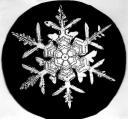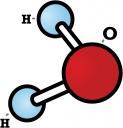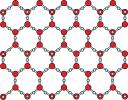Image by Wilson A. Bentley.
Did you know that while no two snowflakes are exactly the same, they are all six-sided? Snowflakes’ hexagonal shapes are due to the molecular structure of ice. As you might know, each water molecule is made of two hydrogen atoms bonded to one oxygen atom and looks something like this:
As water freezes, the molecules are forced to align themselves into a very particular structure – a hexagonal lattice that is the basis for the six-sided snowflakes.
This shape also helps explain why water expands as it freezes, while all other solids contract. Ice takes up more space as a solid and is therefore less dense, meaning that ice floats in liquid water. No other compound behaves this way!
Snowflakes in the Classroom
During the winter months, our thoughts turn to all things cold and we often incorporate snow, ice, and even polar bears into our lessons. Teaching about snowflakes can help you meet science and math standards and incorporate art and even children’s literature into your instruction.
Students can read about water and ice in the Beyond Penguins story “Growing Floaters and Shrinking Sinkers” as a part of a lesson or unit or solids and liquids. This story is available at three grade levels: K-1, 2-3, and 4-5 and as text, color books, and electronic books. The version for grades 4-5 includes a suggested activity: modeling water molecules using gumdrops and marshmallows. Students can create edible water molecules and see the resultant hexagonal structure as they align their models to simulate the formation of ice.
Next, students can compare this molecular model to the actual structure of snowflakes. A great place to start is a web site about Wilson “Snowflake Bentley”, the first person to photograph a single snow crystal in 1885. The site includes a collection of original images of snowflakes which could be used in the classroom to illustrate snowflake structure as well as geometric concepts such as symmetry. A beautiful children’s book, Snowflake Bentley by Jacqueline Briggs Martin, introduces students to Bentley’s life and work and incorporates the history and nature of science into the lesson.
Finally, students can create their own paper snowflakes to model their hexagonal shape. Many variations on these directions exist, and some even have video instructions! Students can also create snowflakes by cutting and gluing together paper-towel rolls although they should take care to make them six-sided. These activities reinforce the science content and allow students to practice measurement skills and demonstrate an understanding of a hexagon and symmetry.
Snowflakes and Standards
This classic winter craft (and the other suggested activities) can meet many different science and math standards, including:
National Science Education Standards: Grades K-4
Physical Science Content Standard: Properties of Objects and Materials
Materials can exist in different states – solid, liquid, and gas. Some common materials, such as water, can be changed from one state to another by heating or cooling.
Science and Technology Content Standard: Understandings about Science and Technology
Women and men of all ages, backgrounds, and groups engage in a variety of scientific and technological work.
Tools help scientists make better observations, measurements, and equipment for investigations. They help scientists see, measure, and do things they could not otherwise see, measure, and do.
History and Nature of Science: Science as a Human Endeavor
Men and women have made a variety of contributions throughout the history of science and technology.
Many people choose science as a career and devote their entire lives to studying it. Many people derive great pleasure from doing science.
National Council of Teachers of Mathematics Standards
Geometry
Analyze characteristics and properties of two- and three-dimensional geometric shapes and develop mathematical arguments about geometric relationships.
Apply transformations and use symmetry to analyze mathematical situations.
Measurement
Apply appropriate techniques, tools, and formulas to determine measurements.
Back to You
What about you? Do you have a favorite snowflake resource, lesson plan, or book that you’d like to share? This site won’t be at its best unless we have input from you – the people who make these ideas come alive to your students everyday! Please post a comment to this blog with suggestions, tips, or comments.
And of course, please check back often for our newest post, download the RSS feed for this blog, or request email notification when new content is posted (see right navigation bar).
That’s it for this time! Until next time, stay cool with this hot topic!




 Follow us on Twitter
Follow us on Twitter


You may be interested in one of the more popular posts on my own blog, which talks about the myth (yes, myth) that no two snowflakes are the same shape:
http://blog.sciencegeekgirl.com/2008/04/12/myth-4-no-two-snowflakes-are-the-same-shape/
One of my sources for that article hypothesized that this myth arose from the publication of a wide sample of snow crystals by Wilson Bentley (who you refer to, and show one of his lovely photographs) in 1931. Bentley only published his very best pictures, which were taking from a specific type of storm. While the final result was astounding (6000 photographs), this is not a very good sample when you consider all the snowflakes that have ever existed in the world.
As a follow up to my previous comment, I just found out about a way to preserve snowflakes using superglue and microscope slides! The process and explanation is a bit long for me to post here, so I’ll just point you to the blog post. What a neat classroom activity this could be (if you can keep your kids from supergluing their fingers together).
http://blog.sciencegeekgirl.com/2009/02/19/superglue-a-snowflake/
THIS IS A REALLY GREAT SITE FOR ALL OF US ADULTS—AND SCHOOL KIDS—MAYBE HELPFUL FOR A WONDERFUL PROJECT !! THANK YOU SO MUCH !!
very cool book and website